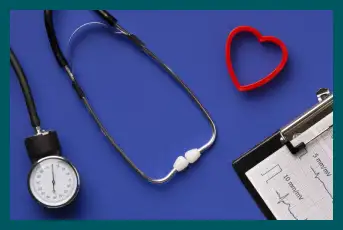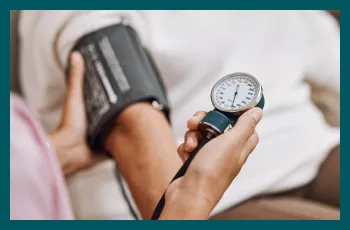Hypotension vs Hypertension
Written By: Dr Nelson Lau, MBBS FRACGP, GP and Digital Health Specialist. Blog published on 22 February 2024 and Blog updated on 26 November 2025

Contents

Overview
Blood pressure affects energy, heart health, and everyday wellbeing. The two conditions present different health risks so people need to understand their blood pressure levels for proper management.What Is Blood Pressure?
The measurement of blood pressure reveals how blood pressure affects artery walls through its forceful contact.| Category | Systolic (mmHg) | Diastolic (mmHg) |
| Low (Hypotension) | < 90 | < 60 |
| Normal | 90–119 | 60–79 |
| Elevated (Pre-hypertensive) | 120–129 | < 80 |
| High (Hypertension Stage 1) | 130–139 | 80–89 |
| High (Hypertension Stage 2) | ≥ 140 | ≥ 90 |
Why Blood Pressure Matters
- Supports normal heart and organ function
- Prevents dizziness, fatigue, or headaches
- Reduces long-term risks like heart disease and stroke
What Is Hypotension (Low Blood Pressure)?
The condition of low blood pressure creates a situation where organs do not receive enough blood circulation which produces various symptoms.Common Causes
- Dehydration – common in warm Aussie weather
- Sudden standing – temporary drop in circulation
- Medications – some antidepressants or heart meds
- Pregnancy – vessels naturally relax
Symptoms
- Dizziness, fainting
- Blurred vision
- Tiredness or nausea
Lifestyle Tips
- Stay hydrated
- Eat small meals
- Stand up slowly
- Avoid long, hot showers
When to See a GP
- Ongoing dizziness or fainting
- Sudden symptoms
- Pregnancy-related low BP
- Suspected medication side effects
What Is Hypertension (High Blood Pressure)?
Hypertension, also called high blood pressure, occurs when the force exerted by blood flowing through arteries consistently remains raised above normal thresholds, putting strain on blood vessels and the heart. This pressure results from the interactions between the volume of blood pumped and the size and elasticity of the arteries carrying it. Like air in a balloon, higher pressure from increased blood volume or constricted, rigid vessels causes an increase in the force inside the balloon. Just as an overinflated balloon grows strained, chronic hypertension places strain on the arteries, organs and other tissues that depend on receiving vital oxygen-rich blood, increasing the risk of serious diseases like aneurysms, kidney disease and stroke over time.Types Of Hypertensions
Stage 1 Hypertension
When blood pressure readings stay between 130-139 systolic or 80-89 diastolic, a patient is considered to have Stage 1 hypertension. Though it elevates heart disease and stroke odds, a modified lifestyle or medication can help to manage their risk.Stage 2 Hypertension
At 140+ systolic or 90+ diastolic readings, the more severe Stage 2 hypertension sets in. The heightened risk of cardiovascular disease frequently necessitates combined medication and lifestyle shifts to reach safer levels. Essentially, the key contrast is the extent of elevation and associated health risk factors. Stage 2 hypertension demands more forceful treatment given its higher risk of potentially serious complications.Common Causes
- Ageing and genetics
- High-salt diet, inactivity, stress
- Conditions like diabetes or sleep apnoea
Symptoms
- Usually none
- Sometimes headaches or shortness of breath
Lifestyle Tips
- Reduce salt
- Walk daily
- Limit alcohol and avoid smoking
- Manage stress
When to See a GP
- Consistently over 130/80
- Chest pain or breathlessness
- Chronic health conditions
Hypotension vs Hypertension
| Feature | Low Blood Pressure (Hypotension) | High Blood Pressure (Hypertension) |
| Typical Symptoms | Dizziness, light-headedness, fainting, blurred vision, fatigue | Usually none; may have headaches or vision changes only when very high |
| Main Risks | Falls, syncope, reduced organ perfusion, shock (severe cases) | Heart disease, stroke, kidney damage, vision loss |
| Common Causes | Dehydration, blood loss, medications (e.g., antihypertensives), endocrine issues, prolonged standing | Genetics, obesity, salt intake, stress, sleep apnea, chronic illnesses (kidney disease, diabetes), poor lifestyle |
| Typical Treatment Approaches | Hydration, salt intake adjustments, compression stockings, slow posture changes, review medications | Diet changes, exercise, weight loss, reduced salt, medications, managing comorbidities |
Experiencing these symptoms? Speak with a doctor within 15 minutes.
See a Doctor now
Available 24/7, across Australia.
Managing Blood Pressure at Home
- Use a trusted home monitor
- Check at the same time daily
- Rest 5 minutes before testing
- Record readings for your online GP
Exams And Tests
Carefully tracking blood pressure is key for properly managing high or low readings. Doctors have several methods to diagnose these conditions and monitor any treatment plans.High Blood Pressure
- Pressure Checks: The main test for high blood pressure involves measuring readings with a blood pressure cuff. Results help categorise levels as normal, elevated, or indicators of stage 1 or 2 hypertension.
- Daytime Monitoring: This uses a portable device to record pressure fluctuations over 24 hours during regular activities. It can identify masked hypertension or cases confined to doctor visits.
- Home Monitoring: Tracking readings at home helps patients watch for medication effectiveness and broader trends. Doctors often recommend this for those at risk or with a diagnosis.
- ECG and Echocardiogram: These tests can detect any electrical or structural heart problems that could be related to high blood pressure.
- Other Tests: These can check for accompanying issues like high cholesterol, kidney dysfunction, or diabetes as possible causes or complications.
Low Blood Pressure
- Pressure Checks: Readings below normal levels on a blood pressure cuff indicate hypotension or low pressure.
- Postural Changes: Measuring blood pressure and heart rate while moving from lying to standing (Tilt Table Test) checks for pressure drops related to postural or neurally mediated hypotension.
- Additional Tests: Blood tests for anaemia, blood sugar, or thyroid problems may uncover an underlying contributor. Heart tests such as an ECG or echocardiogram may help if that is the suspected cause.
- Readings consistently high or low
- New or worsening symptoms
- Medication review or prescription needs
- Concerns about home monitoring
How Hola Health Can Help
Australian-registered doctors at Hola Health can provide the following services to their patients:- They will analyse your blood pressure readings.
- The doctors can give you guidance about your treatment plan and provide necessary care.
- The doctors can write prescriptions for blood pressure medication when needed.
- The doctors can create referral plans and schedule follow-up appointments for your care.
FAQ
What are the typical blood pressure values that adults should expect?
Most adults have blood pressure within the range of 90/60 to 120/80. People should consult their doctor about any persistent high or low blood pressure readings.Can stress or anxiety cause high blood pressure?
Stress and anxiety can lead to temporary blood pressure increases but extended stress exposure will elevate blood pressure levels.Does dehydration lower blood pressure?
Dehydration causes blood pressure to decrease especially during hot summer months. The body's blood volume decreases when fluid levels become low which results in lower blood pressure.How often should I check my blood pressure at home?
Home blood pressure checks should be performed at least three times per week unless your doctor recommends differently. Take three blood pressure readings and calculate their average value.Are online doctors in Australia able to prescribe blood pressure medication?
Online doctors who practice in Australia possess the authority to write prescriptions for blood pressure medications when medical conditions allow it. The doctors can review your current medical treatment and make necessary changes.Feeling sick and unsure why? Speak with a GP online in 15 minutes.
See a Doctor now
Available 24/7, across Australia.
What we treat
- Cough
- Nausea & vomiting
- Fever
- Hayfever
- Fatigue
- Sore throat
- Acne
- Hair loss
- Gout
- Eczema
- Rosacea
- Sunburn
- UTI
- Erectile dysfunction
- Contraception
- Morning sickness
- Morning after pill
- Prostate health
- Anxiety
- Depression
- Stress
- Grief & loss
- Antidepressants
- Premature ejaculation
- Asthma
- Blood pressure
- Blood thinners
- Diabetes
- Cholesterol
- Migraines & headaches
- Allergies
- Body ache
- Heartburn & reflux
- Sleep disorder
- Pain relief
- Gastro
Related Articles
Healthy Blood Pressure By Age: What Is Good Blood Pressure Based On Age?
November 27, 2025Blood Pressure
Healthy blood pressure by age: What is good Blood Pressure based on age? Written by...
Disclaimer
This blog is for general informational purposes only and does not indicate that Hola Health provides all treatments or preventive measures mentioned. It is not intended to be a substitute for professional medical advice. Always seek the guidance of your doctor or other qualified health professional with any questions you may have regarding your health or a medical condition. For emergencies please immediately contact 000. Any medical topics discussed are intended to educate, not to imply availability through Hola Health.
 Facebook
Facebook  X
X  Copy Link
Copy Link



